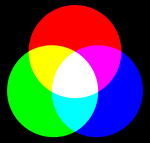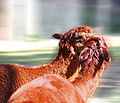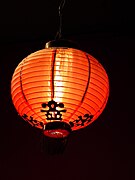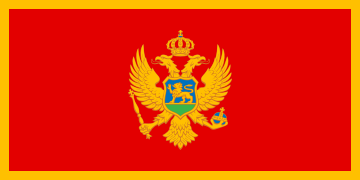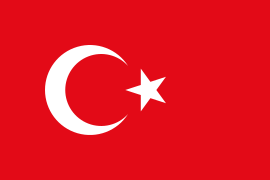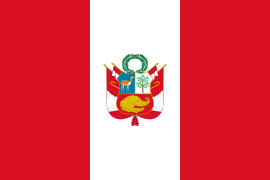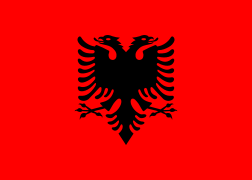Red
Red or red, also poetically pink, is a color that is perceived by photoreception of a light whose wavelength dominant wave measures between 619 and 780 nm. It resembles the coloration of arterial blood in vertebrates.
Red is considered to be a warm color, with a relationship to fire and incandescence. Standard red can be seen in the box on the right, above; the values given below correspond to the same.
The denomination of red color covers the set of colorations similar to the standard: reddish.
Etymology
The word red derives from the Latin rŭssum or rŭsseŭs, 'deep red', related to ruber, 'red', from the Proto-Indo-European *reudh–, 'red'. The term "red" began to be used regularly in the Spanish language during the XV, in the Middle Ages it already existed, but it was rarely used. According to the philologist Joan Corominas, "red" formerly meant a reddish color, while the traditional names for the color of blood were "bermejo", "red" and "encarnado". Red is the only color for which a common Proto-Indo-European root has been found, and it is also the color of blood.
Lexemes
- Lexema erit or eritro, of the Greek erythros), ‘red’ (and this of the indo-European root) *rudh-, ‘red’), associates with the terms that include it with the red color. Some examples of this are the words erythrocyte, Eritrea and Eritrean.
Synonymy
A synonym for red is colorado, from the Latin colorātus, from colorāre, 'to color'. Incarnate > is also a synonym, although it is applied to both the color red and the color flesh or carnation. The bright red color is sometimes called punchó, this from Gallicism very frequent in the first half 19th century ponceau, French name for wild poppy with red petals.
Properties
As a psychological color: primary, warm
Red is one of the four primary psychological colors, along with yellow, green, and blue. In addition, it is considered a warm color, along with orange, yellow and all the colors that tend to these.
As a subtractive color: secondary
In the subtractive color synthesis system, where colors are created by mixing pigments or dyes (paints, dyes, inks), the primary colors are cyan, magenta, and yellow. Red, along with green and blue, are the secondary colors in this system, meaning that when working with pigments of any kind, to obtain red you must mix two of the subtractive primary colors (specifically, yellow and magenta)..
The four-color printing process (used to print, for example, color books and magazines) uses subtractive primary colors with the addition of black. Hence, a process color is described by the percentage of ink of each of these four colors that goes into its composition. Since red is formed by the addition of magenta and yellow, a deep red printed area will be made up of C=0 (0% cyan), M=100 (100% magenta), Y=100 (100% yellow) and K=0 (0% black). See CMYK.
Complementarity
In this system of chromosynthesis, the complementary color of red is cyan.
As a subtractive color in plastic arts: primary
For a long time, red had the status of a subtractive primary color. In fact, it has been part of almost all groups of basic, main or primary colors that different scholars of the subject have proposed throughout history. In the XIX for example, the type of red most used as primary was carmine or crimson. Newton's studies on the nature of light and color gave rise to numerous theories on the subject, not always correct. At the beginning of the XVIII century some painting treatises had adapted the circle of colors created by Newton to the needs of pictorial art and pointed out that the three primary colors were red, yellow, and blue on the Newtonian circle. The practice of using this triad of primaries in paint continues to this day.
Cyan, magenta, and yellow are now considered to be cyan, magenta, and yellow after several centuries of pigment development and color studies, but in art, for technical and traditional reasons, it is generally preferred to continue using the "old" primers.
Complementarity
In this system of chromosynthesis, the complementary color of red is green.
As an additive color: primary
In the additive system of color synthesis, in which colors are made by mixing colored light instead of pigments, red is a primary color, along with green and blue. This means that when working with colored light, it is enough to mix those three colors in different proportions to get all the others. To create the light and dark tones, the lightness is decreased or increased.
This additive system of light colors is what monitors and televisions use to produce colors. In this system, a color is described with numerical values for each of its components (red, green and blue), indicating red with "R", green with "G" and blue with "B". On a value scale from 0 to 255, pure additive red is expressed as R=255 (maximum red), G=0 (no green), and B=0 (no blue). See RGB.
This red was one of the first colors that personal computers could reproduce when they abandoned monochrome, in the early 1980s.
Complementarity
In this system of chromosynthesis, the complementary color of red is cyan.
Spectral Red
Spectral Red is the region of red light of the electromagnetic spectrum that the human eye is capable of perceiving. The wavelength of red light is around 645-700 nm; frequencies lower than red—and therefore longer wavelengths—are called infrared and are not visible. Thus, the color red corresponds to the lowest frequency of light discernible by the human eye.
In the Newtonian spectrum and in the rainbow: first color
In the West, the traditional interpretation of rainbow chromaticism holds that it contains seven colors, corresponding to the seven colors into which Newton divided the spectrum of visible light. In this context, red is considered the first visible color, both in the Newtonian spectrum and in the rainbow.
Wavelengths
or spectral
According to the wavelength, the spectrum that corresponds to red can be divided into four zones:
- From approximately 618 nm to 644 nm, there is a light gradient composed of orange reds.
- From 645 nm to 700 nm the spectral living red is distinguished.
- From 700 nm to 780 nm is one of the extreme areas of the visible spectrum. Red is gradually losing perception in human sight.
- From 780 nm to 1050 nm there is a region that is not considered part of the visible spectrum, but of the near infrared spectrum, however, in special conditions it can be seen its reddish colouring.
Red color blindness
People who have trouble distinguishing the color red are called protanomalous. The protanomaly can consist of a partial ability to perceive the color red or a total inability, depending on the condition of the L cones of the protanomalous individual. The L cones are the cells in the retina that perceive long wavelengths of light; if they are defective, they produce partial red blindness, and if they are completely absent they produce total red blindness, or protanopia.
In nature
Aposematism
In nature, the color red plays an important role in the warning coloration, also called aposematic, of animals. Certain species use this color—generally in combination with black or other contrasting colors—to warn predators of their toxicity or bad taste. The red used in these cases is intense, appropriate to distinguish themselves in the natural environment, where they are more frequent greens, blues and browns.
Blood and other reds in nature
Oxygenated blood is red due to the presence of oxygenated hemoglobin.
When used to describe natural animal coloration, "red" generally refers to a brown, reddish, or ginger color. In this sense it is used to describe the reddish-brown coat colors of dogs and cows and in the names of various animal species or breeds such as the fox, red squirrel, red deer, robin, Calidris canutus , royal redstart, red-winged thrush, red setter, Devon red cattle, etc.
When used of flowers, "red" often refers to purplish (red clover, red hellebore) or pink (red valerian) colors.
Some examples of red in nature:
Symbolism and uses
Signals and stamps
Formerly, a bright red-orange color was called a «signature», in reference to the red color used to mark, highlight and mark documents or other objects, which was made with vermilion, red lead or reddish pigments. The epigraphs of books, which used to be red, were also called rubrics. On the other hand, the sealing wax that was used for centuries to seal documents used to be and is still red, although it is possible to give it any other color.
Others
- World-wide, red represents a “dangerous state”, the red flag indicates danger (against the green flag that has the opposite meaning, for example on the beaches), the “red code” means emergency and the “red button” is, culturally, a last but deadly option.
- The identification of communism with red (the red being the main color of the Soviet Union flag) produced expressions during the Cold War such as "the red threat", the "Red China" (in contrast with the "Nationalist China", the "Free China" or "Red China") Taiwan). In the Spanish civil war, the term “red” was used to refer to the militants loyal to the Second Republic.
- In Chinese symbolism, red is the color of good luck and is used for decoration. Money in Chinese societies is traditionally offered in red packages.
- Red is also used to indicate debts, as in the expression “red numbers”. The practice comes from the Italian accountants who used red ink to indicate the debts and black ink to indicate the assets. Also in pedagogy red is used for reprobate qualifications, while blue is used for approval.
- In the western bags, red indicates a drop in the stock price, while in the East Asian stock exchanges it indicates a rise.
- In China of the Ming dynasty, red was the symbol of the emperor and of the dynasty itself, so the forbidden city has red walls.
- In the Roman Empire the symbol of wealth and economic well-being was red, only the emperors and senators wore some red in the dress.
- In the cultures of extreme east, the red is the color of the south, of the summer and of the element fire, represented by the phoenix bermellion, which is both a constellation and a mythical animal.
- For the ancient Nahua villages (Mexican or Aztec), the red was the color of the east, related to Tezcatlipoca Rojo or Xipe Totec.
Heraldic Red
The heraldic red is called gules. The ancient armorials that are preserved show that it is one of the oldest heraldic enamels.
In the examples below these lines: the coat of arms of Albania, gules with a sable (black) eagle, which represents an exception to the heraldry rules, since it places enamel on enamel; the “Tyrolean eagle” (Tiroler Adler), gules on a silver field, traditional emblem of the alpine region of Tyrol, on the ancient coat of arms of the counts of Tyrol; George Washington's family arms, originating in the s. XIV d. C., which may have inspired the "stars and stripes" of the United States flag.
Vexillological Red
In vexillology, red is a very common color. In some national flags the red area is considerable, and others even use red as the background color. This color is also found in some groups of flags that share national colors for ethnic reasons: the Pan-Arab, Pan-Slavic, and Pan-African colors.
In the examples below these lines: the flag of the People's Republic of China, where red alludes to communism; the "pan-Slavic" red of the Montenegrin flag, adopted from that of the French flag out of sympathy with the ideals of the French Revolution; the "Welsh dragon" (Y Ddraig Goch) of the flag of Wales, a national symbol whose origin probably dates back to the times of the Roman occupation.
Political Red
See political colors: political red.
Liturgical red
See liturgical colors.
In Catholic liturgy, red symbolizes the blood shed for the Gospel and the Holy Spirit. In relation to blood, it is used during the festivities of the martyrs, apostles (except for St. John who did not die a martyr), those related to the Passion of Christ (Palm Sunday, Good Friday, Holy Cross) and with the Eucharist in some traditions, such as the Ambrosian. In relation to the Holy Spirit: Pentecost and during the celebration of the sacrament of confirmation, although in the latter case white can also be used. Currently it is also used in papal obsequies, as a reminder that in the past the Pope never wore a purple (or green) chasuble.
Examples of red colorations
| Name | Sample | Cod. Hex. | RGB | HSV | ||||
|---|---|---|---|---|---|---|---|---|
| Almagre | #DD392E | 221 | 57 | 46 | 4° | 79% | 87% | |
| Bermejo | #D22C21 | 210 | 44 | 33 | 4° | 84% | 82% | |
| Bermellón | #E62E00 | 230 | 46 | 0 | 12° | 100% | 90 per cent | |
| Cardinal | #C41E3A | 196 | 30 | 58 | 350° | 85% | 77% | |
| Carmesi | #A51C30 | 165 | 28 | 48 | 351° | 83% | 65 per cent | |
| Carmine | #D10047 | 209 | 0 | 71 | 340° | 100% | 82% | |
| Cherry | #BE0032 | 190 | 0 | 50 | 344° | 100% | 75% | |
| Scarlet | #FD2D1C | 253 | 45 | 28 | 5° | 89% | 99 per cent | |
| Frambuesa | #E61D52 | 230 | 29 | 82 | 344° | 87% | 90 per cent | |
| Geranio | #E52D33 | 229 | 45 | 51 | 358° | 80% | 90 per cent | |
| Granate | #AA1C47 | 170 | 28 | 71 | 342° | 84% | 67 per cent | |
| Grana | #AB2A3E | 195 | 16 | 58 | 346° | 92% | 76% | |
| Gules | #E21313 | 226 | 19 | 19 | 0° | 92% | 89% | |
| Red hematite | #D4442F | 212 | 68 | 47 | 8° | 78% | 83% | |
| Lacre | #A73330 | 167. | 51 | 48 | 2° | 71% | 65 per cent | |
| Lacre | #C12422 | 193 | 36 | 34 | 1 | 82% | 76% | |
| Red | #BE0032 | 190 | 0 | 50 | 344° | 100% | 75% | |
| Red (NCS) | #C40233 | 196 | 2 | 51 | 345° | 99 per cent | 77% | |
| Red (author) | #E71837 | 231 | 24 | 55 | 351° | 90 per cent | 91 per cent | |
| Orange red | #E82300 | 232 | 35 | 0 | 9° | 100% | 91 per cent | |
| Red aurora | #B93A32 | 185. | 58 | 50 | 4° | 73% | 73% | |
| Red flag | #AD1519 | 173 | 21 | 25 | 358° | 88% | 68% | |
| Coral red | #E51D2E | 229 | 29 | 46 | 355° | 87% | 90 per cent | |
| Rosa Coral | #EB6362 | 235 | 99 | 98 | 0° | 58% | 92% | |
| Indian or Falun Red | #A54332 | 165 | 67 | 50 | 9° | 70% | 65 per cent | |
| Red Ferrari | #CC0000 | 204 | 0 | 0 | 0° | 100% | 80% | |
| Red fucsia | #FF005A | 255 | 0 | 90 | 339° | 100% | 100% | |
| Red neon | #FE575F | 254 | 87 | 95 | 357° | 66% | 100% | |
| Persian red | #CB1D11 | 203 | 29 | 17 | 4° | 92% | 80% | |
| Purple red | #E30049 | 227 | 0 | 73 | 341° | 100% | 89% | |
| Red blood | #9C0001 | 156. | 0 | 1 | 360° | 100% | 61 per cent | |
| Ruby | #E0115F | 224 | 17 | 95 | 337° | 92% | 88% | |
| Teja | #B94841 | 185. | 72 | 65 | 4° | 65 per cent | 73% | |
| Here. | #D5303E | 213 | 48 | 62 | 355° | 77% | 84% | |
| Red wine | #820000 | 130 | 0 | 0 | 0° | 100% | 51% | |
Web Colors
Web colors established by computer protocols for use on web pages include the red shown below. As you can see, it coincides with pure additive red, and is called in programming with the name red (red). Below are the other X11 web reds.
| Red | |
|---|---|
| HTML | #FF0000 |
| RGB | (255, 0, 0) |
| HSV | (0°, 100%, 100%) |
| Protocol | CSS / HTML / VGA / X11 |
| Name | Sample | Cod. Hex. | RGB | HSV | ||||
|---|---|---|---|---|---|---|---|---|
| Clear cut. (LightCoral) | #F0808080 | 240 | 128 | 128 | 0° | 47% | 94% | |
| Orange red (OrangeRed) | #FF4500 | 250 | 69 | 0 | 16° | 100% | 100% | |
| Carmesi (Crimson) | #DC143C | 220 | 20 | 60 | 348° | 91 per cent | 86% | |
| Red brick (FireBrick) | #B22222 | 178 | 34 | 34 | 0° | 68% | 42% | |
| Brown | #A52A2A | 165 | 42 | 42 | 0° | 75% | 65 per cent | |
| Dark red (DarkRed) | #8B0000 | 139 | 0 | 0 | 0° | 100% | 55% | |
Contenido relacionado
Amazon
January 5
December 27



